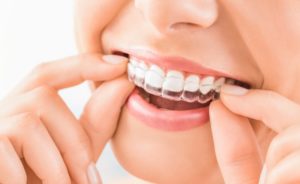March 10, 2023
Invisalign Aligner Not Fitting Correctly? Here are 3 Helpful Tips!

How people choose to straighten their teeth with orthodontics has changed a lot in the past few years. It’s estimated that while 4 million Americans have traditional braces, 11 million are undergoing Invisalign treatment. Obviously, the comfort, convenience, and discretion that come with the removable clear aligners are major benefits that can cause patients to opt for this revolutionary orthodontic. However, while they do offer unparalleled flexibility, sometimes you may find some difficulty getting your aligner to sit correctly onto your teeth. Here’s what to know about how aligners should fit and some easy solutions!
First Things First: How Should My Invisalign Aligner Fit?
Your aligner should fit very snugly in order to apply constant pressure to your pearly whites to move them into the correct position. Another way to say it is that they should fit pretty tightly. On the other hand, there still should be small gaps so there is room for your teeth to be moved. One this is for sure: they should not feel loose or as if they are not applying the necessary force to help you achieve your new smile!
Tips for Helping Your Aligner Fit Correctly
If your aligner isn’t fitting correctly, there are a few simple solutions to try. Remember, it can take a little bit of practice getting your aligner to fit properly. Try the following tips to make the transition easier:
#1. Use Invisalign Chewies
Whether you just started Invisalign treatment or just switched to a new aligner, it can be a challenge to get the initial perfect fit. Invisalign chewies can help successfully push your new tray snugly onto your teeth. They are small, little appliances made from soft material; after chewing on them for a few minutes, your aligner is likely to slide right into place.
#2. Wear Your Aligner for the Recommend Time
If your aligners are ill-fitting, you may want to check to see if you are wearing them for the recommended amount of time. If you do not have them in your mouth for at least 22 hours a day, it can get your treatment off track and your teeth will not be moving as they should be. As a result, your aligners can begin to not fit correctly.
#3. Switch Your Aligner on Time
Generally, you will switch to a new set of aligners every 1-2 weeks. If you try to rush the process and switch too soon, it can impact your treatment timeline, as well as how well your aligner fits. Be sure to allow time for your teeth to move and follow your dentist’s instructions.
If you are still having trouble getting your Invisalign aligners to slide onto your teeth correctly after using these helpful tips, be sure to visit your dentist. They can do a thorough exam and get to the root of the issue. No matter what, there is a solution so you can continue toward your new smile!
About the Author
Dr. James Olsen, an Ann Arbor native, is eager to help you achieve the smile of your dreams. He graduated from the University of Michigan School of Dentistry and successfully completes an average of over 100 hours per year of continuing education. With personalized care and the use of advanced dental technology, he can assist you with any issue that arises with your Invisalign treatment. To schedule an appointment, contact him through his website or call (734) 996-0200.
No Comments
No comments yet.
RSS feed for comments on this post.
Sorry, the comment form is closed at this time.

